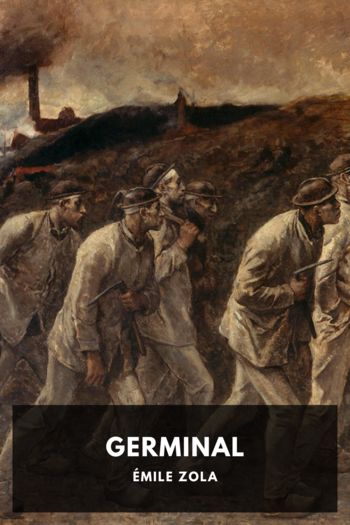His Masterpiece Émile Zola (e textbook reader TXT) 📖

- Author: Émile Zola
Book online «His Masterpiece Émile Zola (e textbook reader TXT) 📖». Author Émile Zola
When Christine rose from her knees, she found him thus occupied. Then, bursting into tears again, she merely said:
“Ah! you can paint him now, he’ll never stir again.”
For five hours Claude kept at it, and on the second day, when Sandoz came back with him from the cemetery, after the funeral, he shuddered with pity and admiration at the sight of the small canvas. It was one of the fine bits of former days, a masterpiece of limpidity and power, to which was added a note of boundless melancholy, the end of everything—all life ebbing away with the death of that child.
But Sandoz, who had burst out into exclamations full of praise, was quite taken aback on hearing Claude say to him:
“You are sure you like it? In that case, as the other machine isn’t ready, I’ll send this to the Salon.”
XOne morning, as Claude, who had taken The Dead Child to the Palais de l’Industrie the previous day, was roaming round about the Parc Monceau, he suddenly came upon Fagerolles.
“What!” said the latter, cordially, “is it you, old fellow? What’s becoming of you? What are you doing? We see so little of each other now.”
Then, Claude having mentioned what he had sent to the Salon—that little canvas which his mind was full of—Fagerolles added:
“Ah! you’ve sent something; then I’ll get it ‘hung’ for you. You know that I’m a candidate for the hanging committee this year.”
Indeed, amid the tumult and everlasting discontent of the artists, after attempts at reform, repeated a score of times and then abandoned, the authorities had just invested the exhibitors with the privilege of electing the members of the hanging committee; and this had quite upset the world of painters and sculptors, a perfect electoral fever had set in, with all sorts of ambitious cabals and intrigues—all the low jobbery, indeed, by which politics are dishonoured.
“I’m going to take you with me,” continued Fagerolles; “you must come and see how I’m settled in my little house, in which you haven’t yet set foot, in spite of all your promises. It’s there, hard by, at the corner of the Avenue de Villiers.”
Claude, whose arm he had gaily taken, was obliged to follow him. He was seized with a fit of cowardice; the idea that his old chum might get his picture “hung” for him filled him with mingled shame and desire. On reaching the avenue, he stopped in front of the house to look at its frontage, a bit of coquettish, precioso architectural tracery—the exact copy of a Renaissance house at Bourges, with lattice windows, a staircase tower, and a roof decked with leaden ornaments. It looked like the abode of a harlot; and Claude was struck with surprise when, on turning round, he recognised Irma Bécot’s regal mansion just over the way. Huge, substantial, almost severe of aspect, it had all the importance of a palace compared to its neighbour, the dwelling of the artist, who was obliged to limit himself to a fanciful knicknack.
“Ah! that Irma, eh?” said Fagerolles with just a shade of respect in his tone. “She has got a cathedral and no mistake! But come in.”
The interior of Fagerolles’ house was strangely and magnificently luxurious. Old tapestry, old weapons, a heap of old furniture, Chinese and Japanese curios were displayed even in the very hall. On the left there was a dining-room, panelled with lacquer work and having its ceiling draped with a design of a red dragon. Then there was a staircase of carved wood above which banners drooped, whilst tropical plants rose up like plumes. Overhead, the studio was a marvel, though rather small and without a picture visible. The walls, indeed, were entirely covered with Oriental hangings, while at one end rose up a huge chimneypiece with chimerical monsters supporting the tablet, and at the other extremity appeared a vast couch under a tent—the latter quite a monument, with lances upholding the sumptuous drapery, above a collection of carpets, furs and cushions heaped together almost on a level with the flooring.
Claude looked at it all, and there came to his lips a question which he held back—Was all this paid for? Fagerolles, who had been decorated with the Legion of Honour the previous year, now asked, it was said, ten thousand francs for painting a mere portrait. Naudet, who, after launching him, duly turned his success to profit in a methodical fashion, never let one of his pictures go for less than twenty, thirty, forty thousand francs. Orders would have fallen on the painter’s shoulders as thick as hail, if he had not affected the disdain, the weariness of the man whose slightest sketches are fought for. And yet all this display of luxury smacked of indebtedness, there was only so much paid on account to the upholsterers; all the money—the money won





Comments (0)